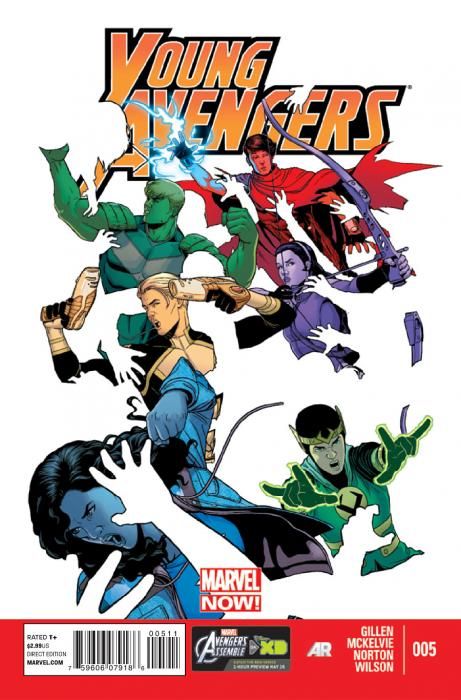"Young Avengers" #5 by Kieron Gillen, Jamie McKelvie and Mike Norton is a partial resolution of the spell-gone-awry conflict, but it also marks an even more important moment. If "Young Avengers" #4 is the first time every team member has been in the same room, "Young Avengers" #5 is the first issue in which the team comes together and fights as one.
McKelvie keeps on taking interesting artistic risks, and those risks keep on paying off. For the scene when the team fights as a unit, he enlarges Loki's pentagram for an unconventional composition, with the points of the star fracturing a double-page spread into five semi-circles. Each pizza-slice panel showcases a character's fighting style. (The team can be summarized as one magic-user, two punchers/strength, and two weapons-users/showboats.) Hawkeye, Wiccan, Miss America and Marvel Boy's segments are further divided into different, smaller semicircles. Amazingly, the flow of action is still clear within segments, and the payoff in visually emphasizing Team Convergence is obvious.
McKelvie and Norton also keep the reader alert by varying the backgrounds, making them sparse or detailed depending on what the narrative moment demands. This nuance in visual atmosphere is especially effective in the opening scene, where Wiccan gets a page of text box voiceovers to himself, brooding about "one spell that never works" before he makes characteristically angsty but emotionally powerful choice. Gillen's pacing is excellent, upping the ante only three pages in, but McKelvie's skills with facial expressions and visual counterpoint are crucial to making the moment all that it should be. He silhouettes Billy's body against alternating panels of blank silence and pattern-like textual noise, making the reader a witness to Billy's internal struggle. Matthew Wilson's cool, clean color choices also heighten the drama of this scene.
Wilson's greens and blues shift into green and red for the next scene with Kid Loki. It begins with a 7-panel, page-long talking-heads monologue. This would usually slow things down, visually, but McKelvie shifts Loki's placement within panels just enough to keep his movements interesting without being distracting. For Kid Loki fans, the four pages here are a goldmine. Gillen employs a standard technique of a double, to show that a character is split in two by internal conflict, but he uses this old device effectively. The complexity and dialogue in this scene are wonderful.
Gillen's ironic humor continues to be one of the hallmarks of "Young Avengers." Yamblr is an excellent recap method and showcase for Gillen's verbal ingenuity. Gillen's narrative risk-tasking inches towards breaking the fourth wall too often, but his dialogue so easily ropes the reader right back in. Thus, he manages to carry off a precarious balance of pop culture references, detached hipster cool and authentic-feeling emotion.
Oddly, "Young Avengers" #5 continues the trend of Gillen's endings being the weakest parts of the story. The stage managing at the end, particularly in the disposition of Billy's parents, feels contrived. Gillen counteracts this by having Miss America blandly point this out to Kid Loki, but this self-aware cleverness doesn't entirely remove the feeling that these events are just a shade too convenient. Another layer of well-done artifice doesn't zero out the original, less acceptable artifice. Similarly, McKelvie's ending pages are also less interesting. There's a seemingly mandatory "team shot," and the roll of mock cinema-like credits is fine, but again, it's not quite as strong as the beginning and middle of "Young Avengers" #5.
Overall, these are small quibbles. "Young Avengers" #5 solidifies the success of Gillen and McKelvie's opening story arc. Gillen and McKelvie's teamwork and abilities have combined to very quickly create a distinctive look, cast of characters and narrative approach. I look forward to seeing what they do next as they take more risks and further carry out their vision.

